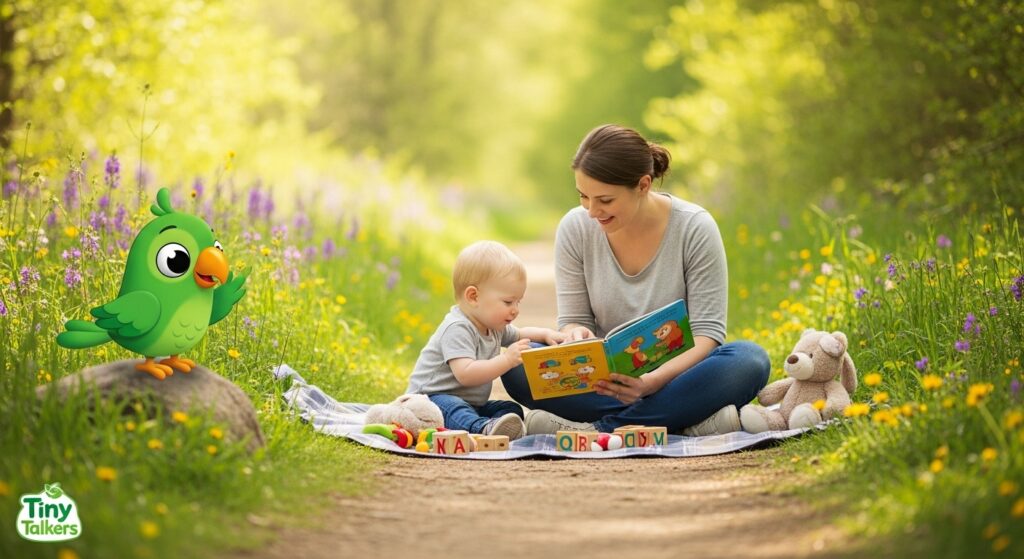Creating an environment that fosters language development in young children is not only beneficial but essential for their growth. Developing strong language skills early on sets a foundation for future communication, reading, and writing abilities. Here are five impactful changes you can make to enrich your home with language opportunities, helping your toddler thrive in their early years.
1. Engage in Constant Conversation
Narrate Daily Activities
One of the simplest ways to surround your child with language is to talk to them about what you’re doing throughout the day. Whether you’re cooking, cleaning, or running errands, narrate your actions. Describe the colors, shapes, and sounds around you. For instance, while preparing a meal, you might say, “I’m chopping the red tomatoes. Do you hear the crunch?” This running commentary helps your child associate words with actions and objects, building their vocabulary in a practical context.
Encourage Back-and-Forth Interaction
Encourage your toddler to respond, even if it’s just with gestures or babbling. Ask open-ended questions to stimulate their thinking and language use. Questions like “What do you think will happen next?” or “How does that make you feel?” encourage them to express themselves and engage in dialogue, further developing their conversational skills.
2. Create a Print-Rich Environment
Access to Books
Ensure that books are easily accessible in your home. A dedicated bookshelf at your child’s level allows them to explore books independently. Rotate the selection regularly to keep their interest alive. Choose a variety of genres, including storybooks, picture books, and educational books that introduce concepts like colors, numbers, and animals.
Label Common Objects
Labeling everyday items around the house can significantly boost vocabulary. Place labels on objects like “chair,” “table,” and “door.” You can also use picture labels for younger toddlers. This visual association reinforces the connection between words and their meanings, making language learning more intuitive.
3. Integrate Music and Rhymes
Sing Together
Incorporate music and nursery rhymes into your daily routine. Singing simple songs and rhymes enhances phonemic awareness—an essential precursor to reading. Songs with repetitive sounds and rhythms, like “Twinkle, Twinkle, Little Star” or “The Wheels on the Bus,” help children recognize patterns in language, making it easier for them to learn new words and sounds.
Use Rhythmic Activities
Encourage activities that involve rhythm and rhyme. Clapping games, rhythmic chants, and bouncing rhymes are not only fun but also support the development of language skills. These activities help children grasp the rhythm and flow of language, which is crucial for their auditory discrimination and memory.
4. Encourage Storytelling and Imaginative Play
Story Time
Dedicate time each day for storytelling. This could be reading from a book or creating your own stories together. Encourage your child to contribute to the story, adding their own twists or endings. This practice boosts their creativity and narrative skills, helping them understand story structure and sequence.
Role-Playing Games
Engage in imaginative play with your child. Set up scenarios like a pretend grocery store or a doctor’s office. These role-playing games allow toddlers to practice language in context, experimenting with new vocabulary and phrases in a fun and meaningful way.
5. Utilize Technology Wisely
Educational Apps
Select age-appropriate educational apps that promote language learning. Many apps are designed to enhance vocabulary and comprehension through interactive activities and games. However, it’s crucial to balance screen time with real-world interactions to ensure that technology complements rather than replaces personal communication.
Video Calls with Family
Use technology to connect with family members who are far away. Video calls provide an excellent opportunity for your child to practice their speaking and listening skills. Encourage your child to share stories or describe their day to relatives, fostering their ability to communicate with different people.
Conclusion
By incorporating these simple yet effective strategies into your daily routine, you can create a language-rich environment that supports your child’s development. Remember, every interaction is an opportunity to nurture their growing minds. Your efforts in providing a diverse and stimulating language environment will pay off in your child’s ability to communicate confidently and effectively. Trust in these practices, and watch your toddler’s language skills blossom beautifully over time.

